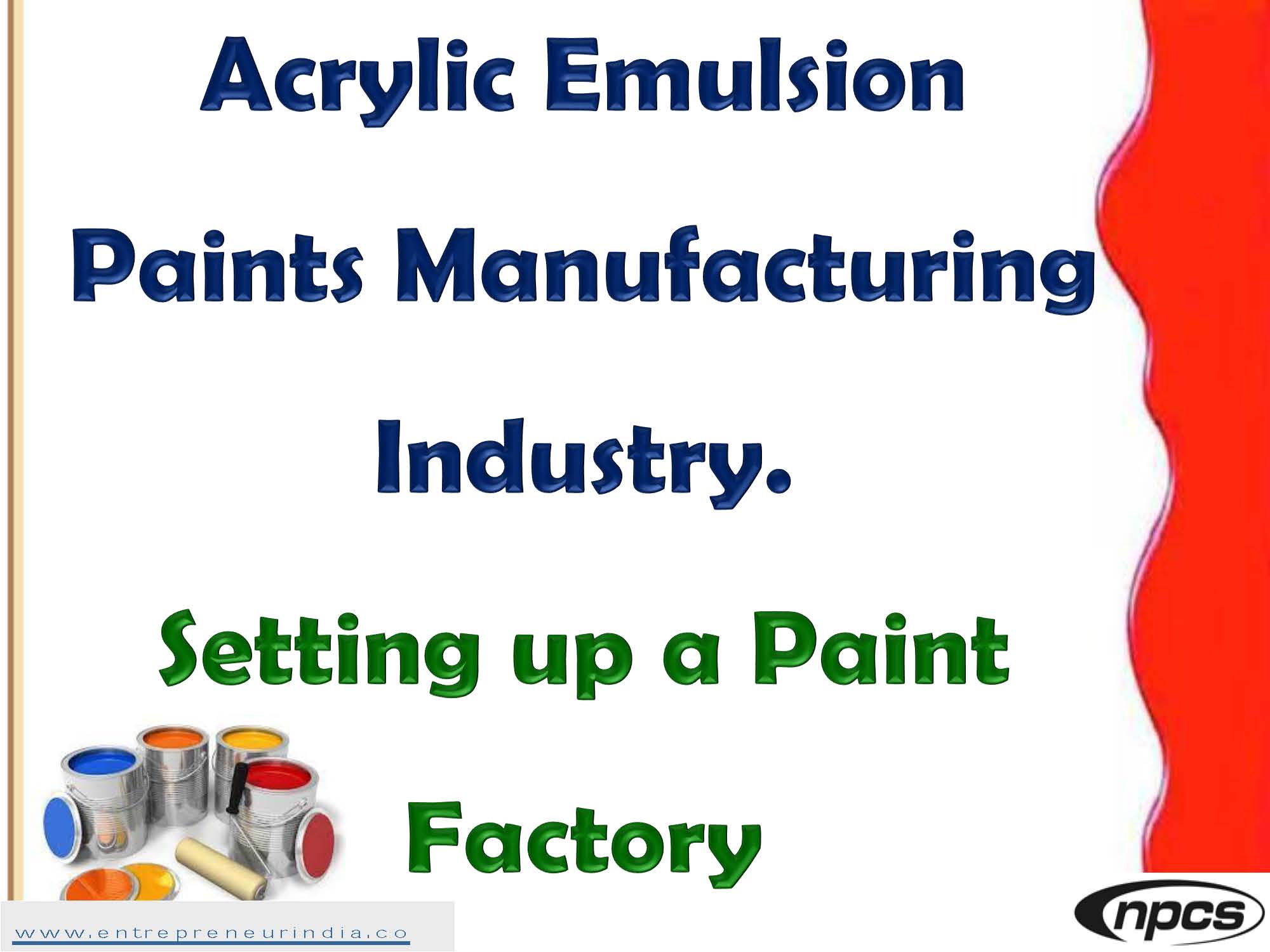
The Acrylic Emulsion Paints Manufacturing Industry has experienced significant growth in recent years, driven by rising demand for eco-friendly, water-based coatings across residential, commercial, and industrial segments. Acrylic emulsion paints are known for their quick-drying, low-VOC (volatile organic compounds), and high-durability properties, making them a popular alternative to solvent-based coatings. With increased construction activities and consumer preference for decorative finishes, the Acrylic Emulsion Paints Manufacturing Industry presents an excellent opportunity for entrepreneurs and manufacturers seeking a scalable and sustainable business model.
Market Overview and Demand Trends
The demand for water-based paints is surging due to strict environmental regulations and consumer awareness about indoor air quality. The Acrylic Emulsion Paints Manufacturing Industry caters to this market shift by offering non-toxic, odorless paints suitable for walls, ceilings, furniture, and exteriors. These paints provide superior adhesion, weather resistance, and aesthetic appeal. In countries like India, China, the U.S., and Brazil, the construction boom and urbanization are fueling consumption.
Moreover, government initiatives promoting low-carbon infrastructure and green buildings further boost the market. Interior decorators, architects, and contractors increasingly recommend acrylic emulsions for their versatility and easy application.
Types of Acrylic Emulsion Paints
The Acrylic Emulsion Paints Manufacturing Industry produces a wide range of variants to meet diverse customer needs. Some of the most common types include:
-
Interior Acrylic Emulsions: Used for interior walls, these paints are washable and come in matt, satin, or glossy finishes.
-
Exterior Acrylic Emulsions: Engineered for weather protection, UV resistance, and anti-fungal properties.
-
Textured Emulsions: Applied for decorative purposes, providing patterns or effects on walls.
-
Primer Emulsions: Serve as a base coat to enhance adhesion and improve the final finish.
-
Elastomeric Coatings: High-performance paints used for waterproofing and crack bridging on exterior surfaces.
Each product type has different resin formulations and additive profiles, allowing manufacturers to position themselves in both premium and economy segments.
Raw Materials and Formulation
The formulation process in the Acrylic Emulsion Paints Manufacturing Industry involves combining high-quality raw materials in specific proportions. The key components include:
-
Acrylic Emulsion Polymers: These are the base binders providing film-forming properties.
-
Titanium Dioxide (TiO?): Used as a white pigment and opacifier.
-
Extenders: Such as china clay, talc, or calcium carbonate for bulk and smooth texture.
-
Coalescing Agents: Help in film formation at lower temperatures.
-
Thickeners and Rheology Modifiers: To maintain consistency and control flow.
-
Defoamers, Preservatives, and Wetting Agents: Improve shelf life and workability.
-
Water: Acts as a carrier medium.
The precise formulation affects paint quality, coverage, drying time, and environmental performance.
Manufacturing Process
The manufacturing process in the Acrylic Emulsion Paints Manufacturing Industry involves the following stages:
-
Raw Material Preparation: Ingredients are weighed according to the batch formula.
-
Premixing: Fillers and pigments are blended with water in a high-speed disperser.
-
Grinding and Milling: Ensures a uniform dispersion of solids to avoid clumps.
-
Addition of Acrylic Binder: The emulsion polymer is introduced slowly to the grind base.
-
Incorporation of Additives: Coalescents, defoamers, and biocides are mixed in.
-
Filtration: Paint is filtered to remove lumps or undispersed matter.
-
Quality Control Testing: Viscosity, pH, sheen, drying time, and coverage are tested.
-
Filling and Packing: Final product is filled into buckets or pouches and labeled.
Modern plants use automated batch processing and closed systems to enhance productivity and maintain hygiene.
Plant Setup and Investment
To establish a unit in the Acrylic Emulsion Paints Manufacturing Industry, the following components are essential:
-
Disperser Machines and Agitators
-
Grinders or Attritor Mills
-
Mixing Tanks (SS or MS)
-
Automatic Filling Machines
-
Weighing Scales and Lab Equipment
-
Dust Collectors and Ventilation Systems
A medium-scale setup requires 5,000–10,000 sq. ft. and an investment of ?40 lakh to ?1.5 crore, depending on capacity and automation. Annual production capacity can range from 500 KL to 2,000 KL.
Licenses and Compliance
Operating in the Acrylic Emulsion Paints Manufacturing Industry requires multiple approvals and adherence to safety norms. Mandatory licenses include:
-
Company or MSME Registration
-
GST Registration
-
Consent to Establish and Operate from Pollution Control Board
-
Factory License and Fire Safety Certificate
-
ISO 9001 and ISO 14001 Certifications (optional but preferred)
Environment-friendly manufacturing with low VOC compliance is increasingly required to meet domestic and export norms.
Profitability and Revenue Model
The Acrylic Emulsion Paints Manufacturing Industry offers high-margin opportunities due to increased acceptance and lower production costs compared to solvent-based paints. Key revenue drivers include:
-
Retail and B2B sales to paint shops, dealers, and builders
-
Private label manufacturing for branded players
-
Government tenders for public housing and infrastructure
-
Exports to Africa, South Asia, and Middle East
Profit margins range from 15% to 30% depending on positioning, raw material sourcing, and production efficiency.
Growth Drivers and Future Outlook
Several factors contribute to the rapid growth of the Acrylic Emulsion Paints Manufacturing Industry:
-
Urban Housing Projects and Smart City initiatives
-
Renovation & Repainting Cycle in existing infrastructure
-
Eco-Conscious Consumer Preferences
-
E-commerce Paint Sales and Home Improvement Apps
-
Technological Advancements in washable, anti-microbial, and odorless formulations
The future will see increased automation, energy-efficient manufacturing, and a shift toward bio-based raw materials. Innovative packaging and color personalization tools will also redefine the consumer experience.
Conclusion
The Acrylic Emulsion Paints Manufacturing Industry stands at the intersection of sustainability, innovation, and consumer demand. With increasing awareness about green building practices and healthier indoor environments, acrylic emulsions are quickly replacing traditional solvent-based products. For entrepreneurs and investors, this sector offers a stable, scalable, and high-growth opportunity. By focusing on quality, compliance, and strategic marketing, businesses can establish a strong foothold in both domestic and international markets.
Niir Project Consultancy Services
An ISO 9001:2015 Company
106-E, Kamla Nagar, Opp. Spark Mall,
New Delhi-110007, India.
Email: npcs.ei@gmail.com , info@entrepreneurindia.co
Tel: +91-11-23843955, 23845654, 23845886, 8800733955
Mobile: +91-9811043595
Website: www.entrepreneurindia.co , www.niir.org





